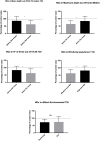Endothelial Nitric Oxide Production and Antioxidant Response in Breath-Hold Diving: Genetic Predisposition or Environment Related?
- PMID: 34305646
- PMCID: PMC8300565
- DOI: 10.3389/fphys.2021.692204
Endothelial Nitric Oxide Production and Antioxidant Response in Breath-Hold Diving: Genetic Predisposition or Environment Related?
Abstract
Introduction: Nitric oxide (NO) is an essential signaling molecule modulating the endothelial adaptation during breath-hold diving (BH-diving). This study aimed to investigate changes in NO derivatives (NOx) and total antioxidant capacity (TAC), searching for correlations with different environmental and hyperbaric exposure.
Materials and methods: Blood samples were obtained from 50 breath-hold divers (BH-divers) before, and 30 and 60 min after the end of training sessions performed both in a swimming pool or the sea. Samples were tested for NOx and TAC differences in different groups related to their hyperbaric exposure, experience, and additional genetic polymorphism.
Results: We found statistically significant differences in NOx plasma concentration during the follow-up (decrease at T30 and increase at T60) compared with the pre-dive values. At T30, we found a significantly lower decrease of NOx in subjects with a higher diving experience, but no difference was detected between the swimming pool and Sea. No significant difference was found in TAC levels, as well as between NOx and TAC levels and the genetic variants.
Conclusion: These data showed how NO consumption in BH-diving is significantly lower in the expert group, indicating a possible training-related adaptation process. Data confirm a significant NO use during BH-diving, compatible with the well-known BH-diving related circulatory adaptation suggesting that the reduction in NOx 30 min after diving can be ascribed to the lower NO availability in the first few minutes after the dives. Expert BH-divers suffered higher oxidative stress. A preliminary genetic investigation seems to indicate a less significant influence of genetic predisposition.
Keywords: breath hold diving; diving; genetic prone; nitric oxide; oxidative stress.
Copyright © 2021 Cialoni, Brizzolari, Samaja, Bosco, Paganini, Sponsiello, Lancellotti and Marroni.
Conflict of interest statement
The authors declare that the research was conducted in the absence of any commercial or financial relationships that could be construed as a potential conflict of interest.
Figures




References
-
- Baranova T. I., Berlov D. N., Glotov O. S., Korf E. A., Minigalin A. D., Mitrofanova A. V., et al. (2017). Genetic determination of the vascular reactions in humans in response to the diving reflex. Am. J. Physiol. Heart Circ. Physiol. 312 H622–H631. - PubMed
-
- Behrendt D., Ganz P. (2002). Endothelial function. From vascular biology to clinical applications. Am. J. Cardiol. 90 40L–48L. - PubMed
LinkOut - more resources
Full Text Sources

